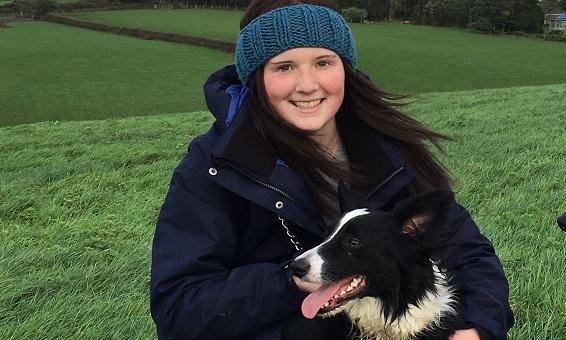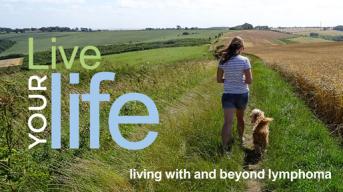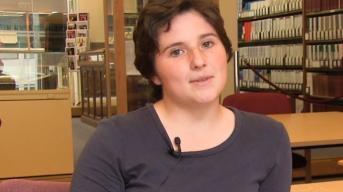Natalia
Natalia shares her experience of being diagnosed with Hodgkin lymphoma at the age of 20 while at university, including the transitional period after treatment and how she is adapting to life after cancer.

At the age of 20 and studying social anthropology at St Andrews University, I felt really driven to be successful. So far things had gone well.
In April 2015, I noticed a lump on my neck. It was just a lump; I had no other symptoms whatsoever. I went to see my GP who thought it best to have it checked out. It was suggested I have a fine needle aspirate which ruled out TB and sarcoidosis. My consultant then decided to take a biopsy of the lump.
Diagnosis
I distinctly recall the day I went for my biopsy results. I felt fairly confident that everything was fine and that I had a simple infection; I had no symptoms and felt really healthy. My friend said she would come along with me and although I didn’t feel this was necessary, I was glad of the company.
But in the waiting room, I started to feel nervous. I went into the consulting room and noticed a nurse was there, holding some information. I suddenly started to panic. 'The biopsy results confirm you have classical Hodgkin lymphoma'. It felt like someone had just walloped me across the face. I began to see black and out of nowhere I started crying uncontrollably. As I left the room I felt lost like never before.
As I left the room I felt lost like never before
The PET scan was carried out 2 days later. I felt really alone and vulnerable during the time I was left on my own for the scan; it was a perfect time to overthink things. I was shocked to discover that I was stage 4A. I thought I would be stage 1 or 2 at most given how well I was feeling.
Treatment and side effects
I was given the option of moving to a hospital with a Principal Treatment Centre for teenagers and young adults. However, I decided to stay at the hospital I was diagnosed in for 2 reasons. Firstly, and most importantly, I felt confident in my doctor, but also it was far easier for me to get to. I was the youngest on the ward by far, but I really appreciated the banter and support from everyone.
I remember quite a few people asking me what I was going to do about university. At the time, with PET scan results, starting treatment and everything that faced me, this was not on my mind at all. I emailed the university simply explaining the situation and saying I wouldn’t be going back until the following September. I felt no obligation to worry about anything else for the foreseeable future – survival and finishing treatment were my only priorities. I started ABVD chemotherapy straightaway.
While everyone around me seemed to be struggling with ABVD treatment, I had virtually no side effects. From the second treatment onwards, I was out horse-riding and taking my dog for walks straight after treatment and had a pretty normal appetite. I actually reached a point where I was convinced that they weren’t putting drugs into me; it wasn’t normal to feel this way. For my own mental sanity, I weirdly wanted to be ill. I needed the confirmation that the drugs were working.
Having said that, I found losing my hair difficult. At the time of collecting my wig I still had all my hair, which was really thick and healthy. The wig didn’t phase me because I never thought I was going to need it. However, by my second chemotherapy session a rather dramatic and noticeable amount of hair was starting to shed. I now hated the thought of the wig with its fakeness and overstyling; it just was not me at all. Instead, I began to comb all my hair back, wear a pony-tail and avoid all pictures.
The plan had always been to have 2 cycles of ABVD, followed by a PET scan, and based on that, reduce the drugs to AVD, removing the bleomycin (B), which can cause long term lung damage. However, the PET scan results after the first 2 cycles showed that my chest was still affected. I needed to change to a more toxic chemotherapy, advanced BEACOPP. I had a PICC line inserted and I was to go from having treatment once every 2 weeks for 2 hours to having to stay in hospital for 4 nights at a time, having 3 hours of drips each day, before returning a week later for a final 30 minute drip, with chemotherapy tablets in between and injections to promote bone marrow production. It was overwhelming, but I managed the BEACOPP well, again with no side effects.
Remission and recovery
On 11 November 2015, after nearly 6 months of chemotherapy treatment, countless tears and incredible support, I was told my PET scan was negative. This meant that I was in remission. I cannot put into words the absolute relief I felt; I could breathe again.
However, I have come to realise that cancer doesn’t simply end when you get the ‘all clear’. Instead I find myself living in fear and confusion. The fear that was once physical has now become emotional. For the past 7 months I was a 20-year-old cancer patient.
Now, in remission, I am struggling to figure out who I am. I had never really come to terms with having cancer, but now it seems even stranger to think I no longer have it.
I am due to start an internship shortly and will then return to university later this year. However, at the moment, I am finding the transitional period after treatment tough. I feel this experience has fundamentally changed me.
Two years on
Two years on, my journey with cancer certainly has not ended.
At a time when everyone thinks you are happy and able to live your life again; when people stop asking whether you are okay and when support systems often fade away, I believe that attending a Live your Life workshop is useful. It can be a place to momentarily offload, share doubts, fears and concerns with others.
June 2016


